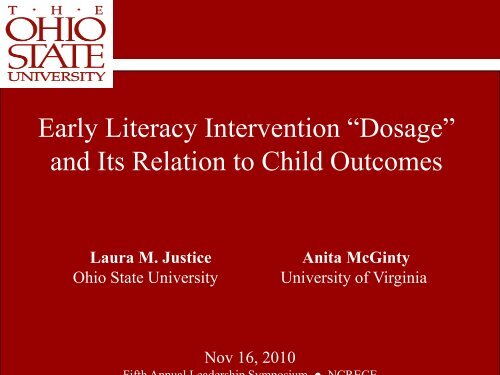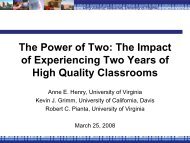Early Literacy Intervention “Dosage” and Its Relation to ... - NCRECE
Early Literacy Intervention “Dosage” and Its Relation to ... - NCRECE
Early Literacy Intervention “Dosage” and Its Relation to ... - NCRECE
Create successful ePaper yourself
Turn your PDF publications into a flip-book with our unique Google optimized e-Paper software.
<strong>Early</strong> <strong>Literacy</strong> <strong>Intervention</strong> <strong>“Dosage”</strong><br />
<strong>and</strong> <strong>Its</strong> <strong>Relation</strong> <strong>to</strong> Child Outcomes<br />
Laura M. Justice Anita McGinty<br />
Ohio State University University of Virginia<br />
Nov 16, 2010
Acknowledgements<br />
• Shayne Piasta, Lori Skibbe, Ryan Bowles, Joan<br />
Kaderavek, Xitao Fan, Helen Ezell, Chris Lankford,<br />
Khara Pence, Tricia Zucker, Sonia Cabell, Amy Sofka,<br />
Aileen Hunt, Allison Breit Smith<br />
• Institute of Education Sciences (Grants R305G050005<br />
<strong>and</strong> R324A080037); National Institutes of Health (NIDCD<br />
Grant DC04933 <strong>and</strong> NICHD Grant HD43204); American<br />
Speech-Language-Hearing Foundation
1<br />
Framework <strong>and</strong> Premises<br />
Preschoolers‟ literacy<br />
skills are consistently<br />
<strong>and</strong> significantly<br />
related <strong>to</strong> later<br />
reading achievement<br />
S<strong>to</strong>rch & Whitehurst, 2002
2<br />
Framework <strong>and</strong> Premises<br />
Some children exhibit<br />
lags in the development<br />
of early literacy skills,<br />
particularly print<br />
knowledge<br />
Justice, Bowles, & Skibbe, 2006
Print Knowledge<br />
• Children‟s implicit <strong>and</strong> explicit knowledge of “the system<br />
of marks that make up a printed language”<br />
(Badian, 2000, p. 37)<br />
– Print-concept knowledge<br />
– Alphabet knowledge<br />
– Emergent writing
3<br />
Framework <strong>and</strong> Premises<br />
<strong>Early</strong> lags in print<br />
knowledge contribute <strong>to</strong><br />
long-term risks in reading<br />
achievement<br />
(about -1 SD at grade 5)<br />
Skibbe, Grimm, Stan<strong>to</strong>n-Chapman, Justice, Pence, & Bowles, 2008
4<br />
Framework <strong>and</strong> Premises<br />
This cascade of<br />
effects can be<br />
dampened through<br />
classroom-based<br />
early literacy<br />
programs<br />
Piasta, Justice, Kaderavek et al., in review<br />
Reading in Grade 1<br />
Woodcock-Johnson III
Designing <strong>and</strong> Implementing Classroom-<br />
Based <strong>Literacy</strong> Programs<br />
Professional<br />
Development<br />
Schedule<br />
Targets<br />
Materials<br />
Techniques
Professional<br />
Development<br />
Print-Referencing <strong>Intervention</strong><br />
Schedule<br />
Dose<br />
Frequency<br />
Duration<br />
Targets<br />
Print Organization,<br />
Print Meaning,<br />
Letters, Word<br />
Materials<br />
Print-salient books<br />
Techniques<br />
Verbal & verbal<br />
references<br />
Scaffolds (high & low)
100<br />
95<br />
90<br />
85<br />
80<br />
75<br />
70<br />
65<br />
60<br />
55<br />
50<br />
Scaffolding Children’s Interactions with Print<br />
very hungry caterpillar<br />
spot bakes a cake<br />
Justice, Skibbe, Canning, &<br />
Lankford, 2005
End of Preschool Impacts<br />
(Justice, Kaderavek, Fan, Sofka, & Hunt, 2009)<br />
High-Intensity Print Referencing vs. High-Intensity Reading<br />
1.15<br />
0.95<br />
0.75<br />
0.55<br />
0.35<br />
0.15<br />
-0.05<br />
Print<br />
Concepts<br />
Alphabet<br />
Knowledge<br />
Name Writing<br />
Effect Size
Program of Research<br />
13
Frequency of Print References<br />
55<br />
50<br />
45<br />
40<br />
35<br />
30<br />
25<br />
20<br />
15<br />
10<br />
5<br />
Fidelity of Teacher Implementation (Piasta et al., 2010)<br />
0<br />
2 4 6 8 10 12 14 16 18 20 22 24 26 28 30<br />
Week
<strong>Intervention</strong> Schedule<br />
Episode:<br />
Locus of<br />
Learning<br />
Dose:<br />
Number of<br />
episodes per<br />
session<br />
Duration:<br />
Total number of<br />
weeks/months<br />
Frequency:<br />
(intensity)<br />
Number of<br />
sessions per<br />
week<br />
Cumulative<br />
<strong>Intervention</strong><br />
Intensity:<br />
Dose x frequency x<br />
duration
Comparison of Schedules<br />
Study Dose Frequency Duration Cumulative<br />
<strong>Intervention</strong><br />
Intensity<br />
Head Start<br />
Study<br />
High-intensity<br />
Pre-K teachers<br />
Low-intensity<br />
Pre-K teachers<br />
9 references 3 per week 8 weeks 216 episodes<br />
31 references 4 per week 30 weeks 3,720 episodes<br />
36 references 2 per week 30 weeks 2,160 episodes
Human Learning <strong>and</strong> Scheduling<br />
• Distributed (spaced)<br />
vs. massed practice<br />
• Longer gaps improve<br />
long-term learning<br />
• Should be exploited in<br />
designing interventions<br />
• Interleaving vs.<br />
blocked practice<br />
• Interleaving improves<br />
learning of multiple<br />
skills<br />
-OMLMWOMWLMO vs<br />
-OOOMMMLLLWWW
Study 1:<br />
<strong>Intervention</strong> Dose <strong>and</strong> Children’s <strong>Literacy</strong> Gains<br />
• 59 preK teachers<br />
• 379 children<br />
• 30-week implementation of book<br />
reading<br />
• Trained <strong>and</strong> untrained teachers<br />
• Dose-response analysis<br />
– variation in active ingredient:<br />
relation <strong>to</strong> child outcomes<br />
• Variables of interest<br />
– Outcome: PK composite<br />
– Dose: average across six<br />
sessions (weeks 4, 8, 12, 16,<br />
20, 24)<br />
– Child language <strong>and</strong> attention<br />
– Classroom quality (CLASS<br />
composite over 2 points)
Study 1:<br />
<strong>Intervention</strong> Dose <strong>and</strong> Children’s <strong>Literacy</strong> Gains<br />
in Classroom Contexts<br />
Print Dosage
Study 1:<br />
<strong>Intervention</strong> Dose <strong>and</strong> Children’s <strong>Literacy</strong> Gains:<br />
Attention as Modera<strong>to</strong>r<br />
Print Dosage
Study 2:<br />
Dose by Frequency Interactions<br />
• 55 preK teachers<br />
• 367 children<br />
• 30-week implementation of book<br />
reading by trained teachers<br />
– High Intensity (120 sessions)<br />
– Low Intensity (60 sessions<br />
• Dose variable<br />
– HI: M = 31, SD = 26<br />
– LI: M = 36, SD = 25<br />
• Variables of interest<br />
– Outcome: PK composite<br />
– Dose: average across 10<br />
sessions<br />
– Intensity: by assignment<br />
– Covariates: age, attendance<br />
initial skills, CLASS,
Structural Model
Dose <strong>and</strong> Frequency Interaction<br />
• In predicting children‟s spring literacy skills:<br />
– in high-dose conditions, low- vs high-intensity<br />
implementation shows no difference<br />
• Other studies show increasing density does<br />
not increase learning (Proc<strong>to</strong>r-Williams & Fey, 2007)<br />
– in low-dose conditions, being in high-intensity<br />
implementation favorable (session dose matters<br />
for children in low-intensity implementation)<br />
• Higher intensity better if few episodes/session
PD for Teachers<br />
• What is the „locus of learning‟ in a curriculum or practice?<br />
• What are current dosage assumptions <strong>and</strong> patterns?<br />
• Is this the ideal dosage pattern considering:<br />
– How the day is organized?<br />
– How children learn?<br />
– The goals for long-term achievement?
Summary<br />
“There is science in what we do, yes,<br />
but also habit, intuition, <strong>and</strong><br />
sometimes plain old guessing…<br />
The gap between what we know<br />
<strong>and</strong> what we aim for persists.<br />
And this gap complicates everything<br />
we do.”<br />
-Atul Gaw<strong>and</strong>e,<br />
Complications (2002)<br />
THANK<br />
YOU!!!



